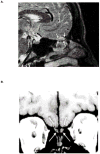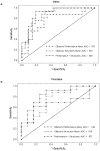Structural anomalies of the peripheral olfactory system in psychosis high-risk subjects
- PMID: 28974405
- PMCID: PMC5878118
- DOI: 10.1016/j.schres.2017.09.015
Structural anomalies of the peripheral olfactory system in psychosis high-risk subjects
Abstract
Background: Olfactory impairments are prominent in both schizophrenia and the preceding at-risk state. Their presence prior to illness predicts poor functional outcome. In schizophrenia, these impairments reflect peripheral olfactory structural abnormalities, which are hypothesized to arise during early embryonic development. If this is correct, then similar structural anomalies should be apparent among clinical high-risk subjects.
Methods: Thirty-nine clinical high-risk (CR) subjects (24M/15F) were compared to 36 low-risk (LR) subjects (19M/17F). Olfactory measures derived from 3T MRI scans included olfactory bulb volume, primary olfactory cortical gray matter volume, and the depth of the olfactory sulcus overlying the bulb. Additionally, nasal cavity volumes were assessed with acoustic rhinometry.
Results: Male CR subjects exhibited bilateral reductions in olfactory bulb volume and abnormal asymmetries of the posterior nasal cavities and olfactory sulci (left reduced relative to right). Post-hoc contrasts also indicated reduced left, but not right, olfactory cortical gray matter volume. Female CRs had no significant abnormalities, although they exhibited similar trend effects. Left olfactory bulb volume correlated, across all CR subjects, with negative, but not positive, symptoms. In a classification analysis, with 80% target specificity, olfactory measurements distinguished male CR from male LR subjects with 93% sensitivity. Among females, the comparable sensitivity was 69%.
Conclusion: Psychosis-risk youths exhibit an array of sexually dimorphic and laterally asymmetric anomalies of the peripheral olfactory system. These are consistent with a developmental disruption primarily affecting male fetuses. These structural biomarkers may enhance the identification of at-risk subjects with poor prognosis, before their clinical trajectory is apparent.
Keywords: Nasal cavity; Negative symptoms; Olfaction; Olfactory bulb; Olfactory sulcus; Psychosis risk.
Copyright © 2017 Elsevier B.V. All rights reserved.
Conflict of interest statement
All authors report that they have no biomedical financial interests or potential conflicts of interest.
Figures



References
-
- Abel KM, Drake R, Goldstein JM. Sex differences in schizophrenia. Int Rev Psychiatry. 2010;22:417–428. - PubMed
-
- Alizadeh R, Hassanzadeh G, Soleimani M, Joghataei MT, Siavashi V, Khorgami Z, Hadjighassem M. Gender and age related changes in number of dopaminergic neurons in adult human olfactory bulb. J Chem Neuroanat. 2015;69:1–6. - PubMed
-
- Brand G, Millot JL, Saffaux M, Morand-Villeneuve N. Lateralization in human nasal chemoreception: differences in bilateral electrodermal responses related to olfactory and trigeminal stimuli. Behav Brain Res. 2002;133:205–210. - PubMed
Publication types
MeSH terms
Grants and funding
LinkOut - more resources
Full Text Sources
Other Literature Sources
Medical

